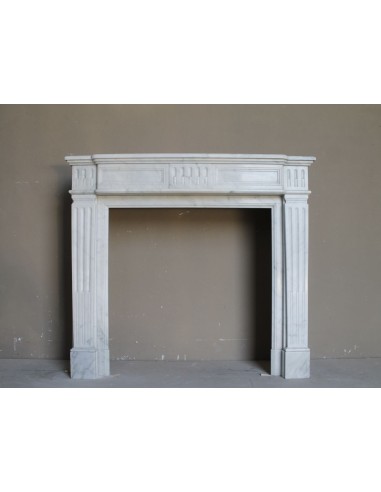TO FULLY UNDERSTAND THIS LOUIS XVI STYLE FIREPLACE MANTEL WE MUST FIRST CLARIFY THAT, AS IS THE CASE IN ALL STYLISTIC FAMILIES, THERE ARE RICH FAMILIES, OTHERS BELONGING TO THE MIDDLE CLASS AND OTHERS, FINALLY, ON THE THRESHOLD OF POVERTY.
The family to which this mantel belongs is the poorest of the Louis XVI people and is called “CANNELURE”.
The word “cannelure” means “groove,” a decoration that, in the field of marble work, is nothing more than a series of “channels” or lines of excavations arranged according to the tastes of the architect designer. Typically said grooves were made on the legs and front of the fireplace.
AT THIS POINT IT IS IMPORTANT TO SAY THAT THE NAME “CANNELURE,” THIS STYLISTIC FAMILY EARNED IT BECAUSE SAID DECORATION, AFTER ALL RELATIVELY SIMPLE, IS THE ONLY ONE THAT SAID FAMILY COULD AFFORD...
However, and so we will give Caesar what is Caesar's, in every family there is a richer, more elegant, stronger component.. And the cannelure specimen I am presenting here is certainly THE RICHEST AND STRONGEST OF HIS FAMILY. The equipment that makes it so different from its little brothers lies mainly in the front (which in the central part juts out over the front) and in the floor (which also juts out to follow the movement of the front... In addition to this “structural” variant, this specific specimen is also endowed with some finesse of detail, such as the so-called “Pompeian flutes” between grooves at the foot of the leg or beautiful reframing in the front. Sometimes details are very important in the overall liking, or are they?! And these are the differences between this specific cannelure and all the other members of the same family published here which are all admittedly, poorer. The excellent quality of its White Carrara “Pure” marble can also make a difference (today there is only one quarry of this marble left, which is called “Gioia”). To carve “poor” fireplaces VERY hardly afforded such Noble Whites as this.
BURGUNDY, NAPOLEON III PERIOD, HEALTHY AND ROBUST.
POSTSCRIPT: IF YOU STILL HAVE PATIENCE TO LISTEN TO ME, I WOULD LIKE TO TELL YOU ABOUT ITS NAME, “QUIRINALE”. NEVER HAS A FRENCH FIREPLACE HAD AN ITALIAN NAME. LET ME PREMISE THAT NO MATTER HOW MUCH EFFORT I HAVE PUT IN THIS LAST HALF-CENTURY, INCLUDING TWO FRUITLESS VISITS TO THE QUIRINAL, I HAVE NOT BEEN ABLE TO GET THE EVIDENCE , THE REASONS FOR THE "VOX POPULI" (LEGEND?!) TO HIS NAME.
It was the last years of the 1970s and in Paris, in a hotel in Montmartre run by Chinese (it was the one that cost the least, moreover those Chinese were very nice and correct, a discovery for me, who had never seen a Chinese in my life..) I met several Italian antiquarians (also there for purchases) and, as you can imagine, we immediately made friends and, oblivious of all competition, some of them helped me a lot in my research, at that time just in its infancy.. So it was that one of these antique dealers said to me... “You know, they offered me in a nice building 4 or 5 fireplaces that they have to dismantle and then sell.... I'm not interested in them, I'm going to buy “Quadrotto Versailles” there (oak floors that cost a madness nowadays), if you want I'll accompany you, I know the builder of the building, he also knows how to dismantle them.... I happily accepted and soon found myself at a construction site in front of some models of nineteenth-century fireplaces that I already knew, and among them, a fireplace that I had seen again but was always introduced to me as “Cannelure” and that's it.. The site manager (his name was Dominique, I still worked there, a few times, who knows if he is still in the world..), on the other hand, presented the fireplace to me as... “Chirinal,” at least I heard this word.. Only after some clarification did I learn that “Chirinal” meant “Quirinal” and that yes that Quirinal was indeed the palace of our prime ministers.... Dominique could not tell me HOW EVER that fireplace model had that name but told me (as I was later able to ascertain) that in France that model was called that.
I REPEAT: I HAVE NOT REACHED DECISIVE AND CLARIFYING ELEMENTS ABOUT THIS STRANGE PAIRING OF OUR QUIRINAL AND A FRENCH FIREPLACE, THOUGH....
However (AND THIS IS CERTAIN HISTORY) I can tell you that the French, in the capacity of Emperor Napoleon, came into possession of the Quirinal (IF I REMEMBER RIGHTLY AROUND 1805) and made major renovations, especially those of 1812, dedicated to the apartments of Napoleon and his family but also and above all ordered with the future KING OF ROME, HIS SON NAPOLEON FRANCIS JOSEPH CHARLES BONAPARTE, who, at the beginning of these works had already... ONE YEAR!!! It cannot be said that Napoleon was disinterested in the future of his offspring?
PROBABLY IN THAT APARTMENT SOME FRENCH FIREPLACE WILL HAVE BEEN PLACED THERE, AND SINCE AT THAT TIME THE STYLISM LOUIS XVI WAS ALL THE RAGE IN FRANCE, WELL, IF TWO + TWO MAKES FOUR, AT LEAST A NICE LOUIS XVI “QUIRINAL” (GIGANTIC, EH, NOT TINY LIKE THIS ONE I'M PROPOSING HERE) WILL HAVE BEEN PLACED THERE, OR NOT?








































































